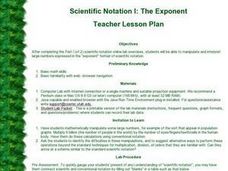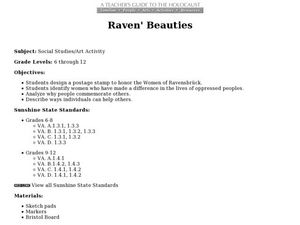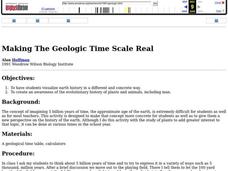Curated OER
What is an animal?
In this animal worksheet, students determine five characteristics that all animals have in common. Using these characteristics, students fill in a table demonstrating what living things have those characteristics.
Curated OER
Plant Responses
In this plant response worksheet, students will explore the different responses plants have to different stimuli, including light and gravity. Students will complete 7 multiple choice questions and 3 fill in the blank questions.
Curated OER
Alive or Not
In this organism worksheet, students review the characteristics that determine if something is alive or not. This worksheet has 5 fill in the blank and 7 matching questions.
Curated OER
X or Y- Does it Make a Difference?
Students examine the X and Y chromosomes. In this research lesson, students use the 5E lesson model as they read articles about human chromosomes then discuss their findings and opinions.
Curated OER
Determining the Effectiveness of Handwashing
Students participate in an experiment in which they grow bacterial colonies. They examine the effects of antibiotics killing the germs. They discuss their findings to end the lesson.
Curated OER
Math Operations/Formulas
Students discuss the ways spreadsheets can help them solve story problems. In groups, they must set up a spreadsheet with the correct formulas based off of different scenerios using the correct order of operations. To end the lesson,...
Curated OER
Fueling the Body
In this nutrition worksheet, students review the organs and enzymes that are part of the digestive system. Then students review the food pyramid by comparing two menus. This worksheet has 9 fill in the blank, 4 true or false, and 5 short...
Curated OER
Scientific Notation II: The Mantissa
Students after completing the Part II (of 2) scientific notation online lab exercises, manipulate and interpret large numbers expressed in the "mantissa and exponent" format of scientific notation.
Curated OER
Scientific Notation I: The Exponent
Students manipulate and interpret large numbers expressed in the "exponent" format of scientific notation.
Curated OER
Scientific Method and Graphing
Seventh graders use the scientific method to determine how many seeds are in a watermelon.
Curated OER
Raven Beauties
Students design a postage stamp to honor the Women of Ravensbr??ck, identify women who have made a difference in the lives of oppressed peoples, analyze why people commemorate others, and describe ways individuals can help others.
Curated OER
Too Much Sun, Not Much Fun
Sixth graders, in groups, research the dangers of too much sun. They are to create and present posters they made showing the information of what happens when one is exposed to too much sun and how to protect your skin from the sun.
Curated OER
Of Tides and Time
Students use the internet to research how the time of day affects the tides. They work together to develop a demonstration of the tide patterns for a month. They create a chart showing the relationship between tides and the phases of...
Curated OER
What Does My Bacteria Look Like?
Students identify Gram positive and Gram negative bacteria using staining techniques. Students research importance of identification of bacterial types in diagnosing bacterial diseases.
Curated OER
Making The Geologic Time Scale Real
Students construct a geologic timeline the size of a football field. They work in small groups to calculate the yardage for significant events in the Earth's history and then as a class pace out all of the events.
Curated OER
Elegant Embryology
Students observe embryogenesis in action through early stages of development of eggs. They observe cultures with dissecting and compound microscopes. They draw their egg, record any details and observe for changes. They compare their...
Curated OER
Making The Geologic Time Scale Real
Students are assigned significant geologic events in Earth's history. They convert the date of the events into distances and then space themselves (on an outside playing field) away from other groups, to represent time between various...
Curated OER
Arctic Microclimates
Students identify, measure, and average micro-climatic temperatures in a particular region. They draw a small-scale map of an area to be sampled (classroom, playground, park, backyard) and identify potential locations for...
Curated OER
Genetic Traits
Students supplement their study of genetics by collecting and analyzing information about their own and their classmates' characteristics and traits. Students create a database of traits and characteristics to compare and contrast.
Curated OER
How Germs Spread
Fourth graders investigate how germs spread in this lesson. They listen to "The Flea's Sneeze" by Lynn Downey and make predictions on why the hog began sneezing. They then conduct an experiment using flour and paper cups demonstrating...
Curated OER
6.1 Computing Components
Students define computer terms such as hardware, software, input and output devices, central processing unit, etc. in their own words, and relate terms to computer system they are using.
Curated OER
Plants
Student identify the characteristics of plants. Through hands-on demonstration, they create a model of plant parts. High schoolers differentiate between the major divisions of the plant kingdom with a particular emphasis on the...
National First Ladies' Library
E.T. Phones Home: The History of the Telephone
Students create illustrated timelines of the telephone's history. In groups, they research 25-year sections beginning in 1876. Once each group has completed their portion of the timeline, they are all assembled to create one banner.
Curated OER
The Excretory System
In this excretory system worksheet, students read a brief excerpt about water balance and the excretory system. Then they identify what compound birds, insects and reptiles living in dry habitats excrete. Students also describe how...
Other popular searches
- Cell Division and Mitosis
- Mitosis Cell Division
- Cell Division Mitosis Ppt
- Cell Division 23 Chromosomes
- Cell Division Cancer
- Embryo Cell Division
- Cell Division Song
- Cell Division Mitosis Pot
- Cell Division of Labor
- Online Cell Division
- On Line Cell Division
- Genetic Cell Division

























